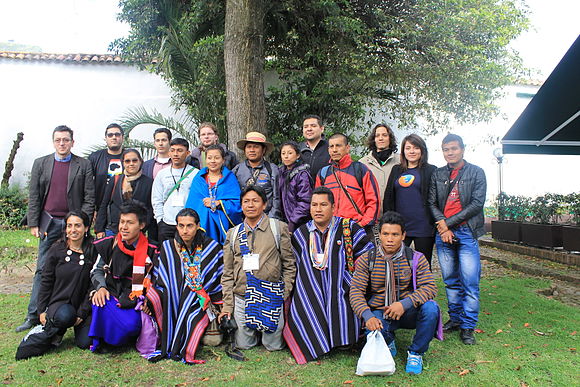
Here are the highlights from the Wikimedia blog in August 2015.
Hundreds of “black hat” English Wikipedia accounts blocked following investigation

Hundreds of ‘black hat’ accounts on English Wikipedia were found to be connected during the investigation. The usernames (green) and IP addresses (yellow) have been removed from the image. Graph by James Alexander, freely licensed under CC BY-SA 3.0.
After weeks of investigation, volunteer editors on English Wikipedia announced on August 31 that they blocked 381 user accounts for “black hat” editing. In addition to blocking these “sockpuppet” accounts—a term that refers to multiple accounts used in misleading or deceptive ways—the editors deleted 210 articles created by these accounts. With these actions, volunteer editors have taken a strong stand against undisclosed paid advocacy.
The Hunt for Tirpitz

The German battleship Tirpitz shortly before being launched into the sea. When it entered service in 1940, it was one of the largest and most modern battleships in the world. Photo from the German Federal Archives, freely licensed under CC-by-SA 3.0.
Wikipedia editor and administrator Nick Dowling has written three featured articles on English Wikipedia about the Royal Navy’s attempts to sink the German battleship Tirpitz during the Second World War. He talks about the obstacles he faced, and how he overcame them.
My life as an autistic Wikipedian

Guillaume sitting on a bench. Photo by Cary Bass, freely licensed under CC BY-SA 3.0.
Two years ago, Wikipedia editor Guillaume Paumier discovered that he was on the autism spectrum. As he learned more about myself and the way his brain worked, Guillaume started to look at past experiences through the lens of this newly-found aspect. He shares some of what he has learned along the way about his successes, failures, and many things that confused him in the past, notably with regards to his experiences in the Wikimedia movement.
Content Translation updates from Wikimania 2015

Content Translation session at Wikimania 2015. Photo by Amire80, freely licensed under CC BY-SA 4.0.
Wikimania 2015—the eleventh edition of the annual gathering of Wikimedians from around the world—was recently held in Mexico City. The Wikimedia Foundation’s Language Engineering team participated in the Hackathon and Wikimania sessions, hosting several talks and two translation workshops. The primary focus was the Content Translation project—interacting with users, understanding their issues, and raising awareness about this new article creation tool.
Content Translation is available as a beta-feature for all logged-in users on Wikipedias of all languages. You can follow the instructions on how to get started with the tool. Additional help is available in the FAQ section. We also invite participants to our testing sessions and you can also help translate the UI messages for Content Translation. You can provide feedback on the project talk page.
Using Wikipedia to preserve indigenous languages of Colombia
The group of the participants. Photo by Diego F. Gómez, freely licensed under CC-BY-SA 4.0.
The User Group Wikimedistas de Colombia gathered this past June in Bogotá, Colombia, to begin discussions on the ways Wikipedia can be used to document and share endangered indigenous languages in the country. Indigenous language speakers came from all over Colombia to share their experiences, knowledge, and resources to help.
Participants brainstormed the impact Wikipedia could have on the indigenous languages of Colombia, including the use of the site as a way to help younger generations of indigenous language speakers access articles and media in their own languages. This would help bridge the gap between indigenous languages and education, where Spanish dominates the classroom as the spoken language.
When cultural heritage gets a digital life

Coding da Vinci featured 20 different projects and made 600,000 files available to the Wikimedia Commons. Photo by Thomas Nitz/Open Knowledge Foundation Deutschland, freely licensed under CC BY 2.0.
An additional 600,000 free files are now available for use on the Wikimedia Commons thanks to Coding da Vinci, a recent cultural data hackathon held at Berlin’s Jewish Museum. They range from century-old films to recordings of mechanical pianos, World War II photographs, scans of dried flowers, and other art and heritage, all sourced from German museums, archives, and libraries.
Andrew ShermanDigital Communications InternWikimedia Foundation
Photo Montage Credits: “Encuentro de Activistas Digitales de Lenguas Indígenas – Colombia 2015 – 3.JPG” by Diego F. Gómez, freely licensed under CC-BY-SA 4.0.; “Taipei_Wm2007_Guillaume.jpg” by Cary Bass, freely licensed under CC BY-SA 3.0.; “OrangeMoody-BubbleGraphCombined-Nolabels.jpg” by James Alexander, freely licensed under CC BY-SA 3.0.; “Coding da Vinci 2015 – Preisverleihung (18880680843).jpg” by Thomas Nitz/Open Knowledge Foundation Deutschland, freely licensed under CC BY 2.0.; “Wikimania Translathon 20150718 162444.jpg” by Amire80, freely licensed under CC BY-SA 4.0.; Collage by Andrew Sherman.

Can you help us translate this article?
In order for this article to reach as many people as possible we would like your help. Can you translate this article to get the message out?
Start translation
